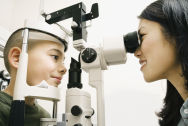Eye Examination
The initial eye examination will last between 30 and 60 min and will consist of a number of tests which will include the following:
Case History
Most eye care practitioners will begin the eye examination by taking a detailed case history. The purpose of the case history is to provide the eye care practitioner with an idea of what may be affecting your vision. It also highlights any potential problems that might arise because of your family’s eye health history, your work habits and your occupational vision demands.
Eye Health
Optometrists viewing the eye of a boy with a slitlampA healthy eye is of utmost importance for a successful Orthokeratology procedure. The Orthokeratology practitioner will spend a fair amount of time examining the structures of the eye to rule out any eye pathology.
 An instrument called a biomicroscope or slit lamp is used to examine the external structures of the eye and lids. The internal structures will be examined using a number of different instruments for example a direct or indirect ophthalmoscope or a hand held fundus lens in conjunction with the slit lamp. Even photography can be used to analyse the retina of the eye using a retinal fundus camera.
An instrument called a biomicroscope or slit lamp is used to examine the external structures of the eye and lids. The internal structures will be examined using a number of different instruments for example a direct or indirect ophthalmoscope or a hand held fundus lens in conjunction with the slit lamp. Even photography can be used to analyse the retina of the eye using a retinal fundus camera.
Visual Acuity Test
This test is performed using a Snellen chart and measures your visual acuity. You will be asked to read progressively smaller rows of letters or numbers until they become indistinguishable. The last row correctly read will be noted by the practitioner and is normally marked in notations of feet (20/20), meters (6/6) or fractions (1.00).
Refraction
First an objective refraction is performed using either a hand-held instrument called a retinoscope or a computerised system called an autorefractor. The result of this test will provide the objective measurement of your eye's refractive error.
Next the subjective refraction will be performed. This test refines your prescription based on your subjective responses to a variety of lenses. The Orthokeratology practitioner will perform this test using a phoropter or trial frame. The test result will quantify your refractive error and will form the basis for calculating the corrective power needed for the Orthokeratology lens.
Other tests
Other test can be included in the initial examination as per the discretion of the eye care practitioner. These can include tests for eye pressure (tonometry), focusing skills, eye movement skills, convergence skills, colour vision, stereo vision and visual fields.
Final results
The comprehensive eye examination is critical to prescribing the correct Orthokeratology lens for your eyes. The eye health examination further helps to determine whether any medical treatment is necessary prior to beginning the accelerated overnight Orthokeratology treatment. Using this data, coupled with the corneal topography results, the Orthokeratology practitioner can accurately estimate and discuss the Ortho-k treatment prognosis and program length with you.